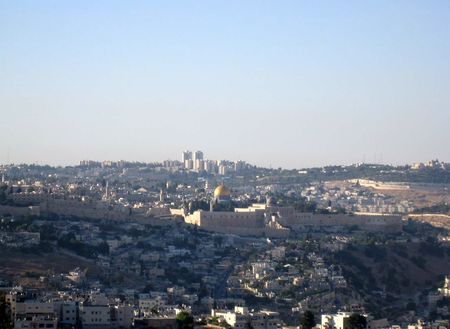Jerusalem: celestial and worldly
Alexey Shaburov, Director of the Contemporary Museum of Calligraphy and his councilor Lyudmila Kulanina visited the holy places and went sightseeing around Jerusalem where Avraham-Hersh Borshevsky, the consultant of the International Exhibition of Calligraphy acted as their guide.
The four-thousand-year old Jerusalem is said to be the holiest place in the world for the Jews and Christians and the third holiest site for the Muslims.
A breath-taking view of the ancient and modern capital of Israel presents itself from the vertical focus of the city, the YMCA stone bell-tower decorated with English calligraphy of Bible verses about Jerusalem carved in stone.

The Old City enclosed by a vallum dating back to the reign of Suleiman the Magnificent (15th century) is included by UNESCO in the list of the World Heritage sites. Here the area of only 1 sq. km. contains an incredible quantity of holy places and shrines located in four historic parts of the city: Muslim, Christian, Jewish, and Armenian.
Leaving behind the busy streets of the Muslim Quarter the guests of Israeli capital visited the Christian Quarter where the key sanctuary of the Christians, the Church of the Holy Sepulchre, is located. As they continued their walking tour, they approached the Western Wall of the Temple of Jerusalem, commonly known as the Wailing Wall already in the Jewish Quarter.
An important event of the visit was the meeting of Alexey Shaburov and the Director of the National Library of Israel, which laid the foundation for cooperation with the Contemporary Museum of Calligraphy and International Exhibitions of Calligraphy.
Avraham-Hersh Borshevsky, a renowned master of sacral Hebrew calligraphy, welcomed Alexey Shaburov and Lyudmila Kulanina in his art studio located near the the Belz Great Synagogue. The guests were able to see with their own eyes the World Famous Mezuzah, the acknowledged masterpiece of Jewish calligraphy. Other artist’s works also evoked meticulous attention of the guests.
Alexey Shaburov visited a unique exhibition entitled “The Three Faces of Monotheism” at the Bible Lands Museum. In the Israel Museum located nearby the guests from Russia were able to study the artifacts of the period of the First Temple (900-500 BC), the Dead Sea Scrolls (150 BC – 70 AD) and a model of Jerusalem of the time. The Shrine of the Book contains the most ancient script Tanach (Jewish part of the Bible) dating back to the 10th century – Keter Aram Soba (The Aleppo Codex).
The day rich in impressions ended with a visit to Izzy Pludwinski, one more exhibitor of the International Exhibition of Calligraphy, an outstanding master of Jewish calligraphy. In his cozy workshop he demonstrated the finished Haggadah of Pesach and a semi-finished handwritten Pentateuch. The guests also enjoyed a spontaneous lesson of Hebrew calligraphy from Izzy Pludwinski.
Man′s beauty is in the beauty of his writing.



